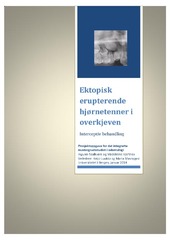Ektopisk erupterende hjørnetenner i overkjeven. Interceptiv behandling
Master thesis
Permanent lenke
https://hdl.handle.net/1956/15510Utgivelsesdato
2015-01-26Metadata
Vis full innførselSamlinger
Sammendrag
Objective: Extraction of deciduous maxillary canines is a commonly used interceptive treatment to facilitate the eruption of canines with deviating eruption path. The aim of the study was to record the rate of referrals for extraction of deciduous maxillary canines in the student clinic. The characteristics of the atypical position of the permanent canines were also evaluated, using panoramic x-rays. Materials and methods: This was a retrospective study in design, using existing material from the patient archives in the dental clinic of the orthodontic department. 1348 patient files from the school year 2013/14 were screened for referrals for bilateral extractions of maxillary deciduous canines. The age, gender and rate of referred patients were recorded. Characteristics of the position of the permanent canines on panoramic radiograms used for extraction-decision were evaluated. Inclination to the midline and to the long axis of the lateral incisor, as well as the anteroposterior and vertical position were recorded. Canine root development was categorized in 3 groups. A control group with normal eruption of the maxillary canines was chosen between the patients not referred for extraction, and was compared to the extraction group, considering maxillary canines characteristics. Results: 4,6 % of the patients were referred for extraction of 53 and 63. There was a significant difference between the extraction and control groups for inclination to the midline and lateral incisor, and the anteroposterior position of the canine. The extraction group showed a more inclined canine and a more mesial position of the cusp tip. There was no significant difference for the vertical position of the canine, nor the root development between the two groups. The average" patient referred for extraction of the deciduous canines was approximately 10,5 years old, with a canine inclination of 24° towards the midline and 34° towards the lateral incisor. The cusp tip was positioned overlapping the lateral incisor. Conclusions: The rate of referrals for extraction was 4,6 % of school children screened for malocclusions at the university clinic. Position and angulation differed significantly between the patients referred for extraction and the control groups. As there was no follow up, no conclusions can be made about the treatment effect. Mål med studien: Målet med studien var å registrere frekvensen av henvisning for ekstraksjon av primære maxillære caniner i studentklinikken. Gjennomsnittsverdier for caninens posisjon ble beregnet for både henviste pasienter og en kontrollgruppe. For alle pasientene ble OPG brukt for å vurdere posisjon av de permanente maxillære caninene. I tillegg ble pasientens kjønn og alder registrert. Material og metode: Studien hadde et retrospektivt design, der vi brukte eksisterede materiale fra studentklinikken (UiB). 1348 pasientjournaler ble gjennomgått for å finne pasienter henvist for ekstraksjon av 53 og 63. Kjønn, alder og henvisningsfrekvens ble registrert. OPG ble brukt til å bestemme caninens posisjon etter metoden til Gravdal Brusveen et.al (2012). Caninens rotutvikling ble kategorisert i tre grupper. Resultater: 4,6 % av pasientene ble henvist for ekstraksjon av 53 og 63. Ekstraksjonsgruppen og kontrollgruppen avvek signifikant med tanke på vinkel α og β og den anteroposteriore posisjonen (MP). Det var ikke noen signifikant forskjell med tanke på den vertikale posisjonen, og heller ikke på rotutviklingen på de permanente caninene (tabell 3). En «gjennomsnittlig» pasient ble henvist for ekstraksjon av 53 og 63 ved en alder på omtrent 10,5 år, med en inklinasjon av permanente canin på 24° mot midtlinjen og 34° i forhold til den laterale incisiven. Konklusjon: Henvisningsfrekvensen var 4,6 %. Posisjon og vinkling avvek signifikant mellom henviste pasienter og kontrollgruppen. Siden vi ikke fulgte opp pasientene, kan ingen konklusjon gis om behandlingens effekt.
